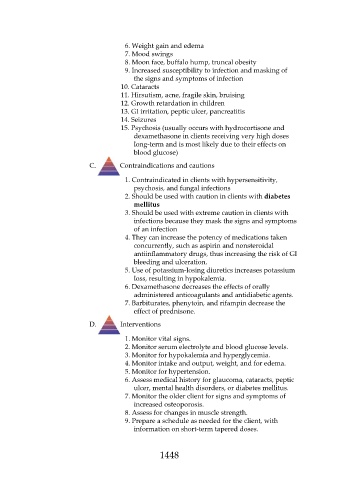Page 1448 - Saunders Comprehensive Review For NCLEX-RN
P. 1448
6. Weight gain and edema
7. Mood swings
8. Moon face, buffalo hump, truncal obesity
9. Increased susceptibility to infection and masking of
the signs and symptoms of infection
10. Cataracts
11. Hirsutism, acne, fragile skin, bruising
12. Growth retardation in children
13. GI irritation, peptic ulcer, pancreatitis
14. Seizures
15. Psychosis (usually occurs with hydrocortisone and
dexamethasone in clients receiving very high doses
long-term and is most likely due to their effects on
blood glucose)
C. Contraindications and cautions
1. Contraindicated in clients with hypersensitivity,
psychosis, and fungal infections
2. Should be used with caution in clients with diabetes
mellitus
3. Should be used with extreme caution in clients with
infections because they mask the signs and symptoms
of an infection
4. They can increase the potency of medications taken
concurrently, such as aspirin and nonsteroidal
antiinflammatory drugs, thus increasing the risk of GI
bleeding and ulceration.
5. Use of potassium-losing diuretics increases potassium
loss, resulting in hypokalemia.
6. Dexamethasone decreases the effects of orally
administered anticoagulants and antidiabetic agents.
7. Barbiturates, phenytoin, and rifampin decrease the
effect of prednisone.
D. Interventions
1. Monitor vital signs.
2. Monitor serum electrolyte and blood glucose levels.
3. Monitor for hypokalemia and hyperglycemia.
4. Monitor intake and output, weight, and for edema.
5. Monitor for hypertension.
6. Assess medical history for glaucoma, cataracts, peptic
ulcer, mental health disorders, or diabetes mellitus.
7. Monitor the older client for signs and symptoms of
increased osteoporosis.
8. Assess for changes in muscle strength.
9. Prepare a schedule as needed for the client, with
information on short-term tapered doses.
1448

